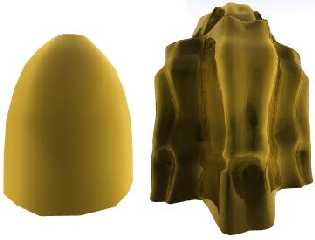|
 |
"Tor Olav Kristensen" <tor### [at] hotmail com> wrote in message
news:3CC15D49.9FFB7AC0@hotmail.com...
>
> I like the results Shay !
>
Thank you.
> Have you tried to make recursive subdivision
> algorithms ?
>
I'm not 100% sure what you mean, but I'm guessing that you mean an algorithm
which only adds triangles where they are "necessary." If this is the case, I
think that splitting each edge as many times as necessary in one pass might
be simpler and faster than finding the edges and dividing them with multiple
passes. This was my intention at first, but I decided against it.
The main reason is that doing so destroys the appearance of the mesh
approximation. I believe after a *lot* of consideration and experimentation
that in most cases the number of vertices saved is not worth the sacrifice
in appearance. An algorithm which splits edges when the angle is over a
certain threshold attempts to place vertices where they are most needed. It
fails, however, to take into account viewing angle and the places on the
shape where a person's eye will generally check for accuracy.
As an experiment, I created three spheres. One sphere was made up of 24
quads (48 triangles), a second was made by splitting latitude and longitude
lines into quads in the middle and a pie on the top and bottom, the third
was made by dividing a buckey into "pies" one time. All of the spheres had a
reasonably similar number of triangles (really the buckey had a lot more),
and the buckey was probably the closest to what a recursive algorithm would
produce. Without normals, the best looking sphere was the quad sphere. The
quad and the buckey also had the advantage that the faces could be divided
over and over again and the triangles would all remain about the same size
as each other. When I also considered that a buckey was much slower to add
on to the end of a cylinder or come, quad was the obvious winner, despite
whatever disadvantages it may have.
The second reason was that I wanted to make a macro which worked one pass at
a time. I found that by changing the weights by a multiplier for each pass,
some useful "special-effects" could be created (see attached pic.)
Despite all of this, I can see times where using triangles may be necessary.
In those cases, I will still reduce as far as possible with quads to
preserve the look of the mesh.
I am very interested in your or anyone else's opinions about my conclusions.
If anyone is really interested, I can reproduce the experiment.
-Shay com> wrote in message
news:3CC15D49.9FFB7AC0@hotmail.com...
>
> I like the results Shay !
>
Thank you.
> Have you tried to make recursive subdivision
> algorithms ?
>
I'm not 100% sure what you mean, but I'm guessing that you mean an algorithm
which only adds triangles where they are "necessary." If this is the case, I
think that splitting each edge as many times as necessary in one pass might
be simpler and faster than finding the edges and dividing them with multiple
passes. This was my intention at first, but I decided against it.
The main reason is that doing so destroys the appearance of the mesh
approximation. I believe after a *lot* of consideration and experimentation
that in most cases the number of vertices saved is not worth the sacrifice
in appearance. An algorithm which splits edges when the angle is over a
certain threshold attempts to place vertices where they are most needed. It
fails, however, to take into account viewing angle and the places on the
shape where a person's eye will generally check for accuracy.
As an experiment, I created three spheres. One sphere was made up of 24
quads (48 triangles), a second was made by splitting latitude and longitude
lines into quads in the middle and a pie on the top and bottom, the third
was made by dividing a buckey into "pies" one time. All of the spheres had a
reasonably similar number of triangles (really the buckey had a lot more),
and the buckey was probably the closest to what a recursive algorithm would
produce. Without normals, the best looking sphere was the quad sphere. The
quad and the buckey also had the advantage that the faces could be divided
over and over again and the triangles would all remain about the same size
as each other. When I also considered that a buckey was much slower to add
on to the end of a cylinder or come, quad was the obvious winner, despite
whatever disadvantages it may have.
The second reason was that I wanted to make a macro which worked one pass at
a time. I found that by changing the weights by a multiplier for each pass,
some useful "special-effects" could be created (see attached pic.)
Despite all of this, I can see times where using triangles may be necessary.
In those cases, I will still reduce as far as possible with quads to
preserve the look of the mesh.
I am very interested in your or anyone else's opinions about my conclusions.
If anyone is really interested, I can reproduce the experiment.
-Shay
Post a reply to this message
Attachments:
Download 'seJPG.jpg' (11 KB)
Preview of image 'seJPG.jpg'

|
 |




![]()